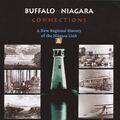
The Pan-American Grill & Brewery, decked out with large historical images that hide innovative sound-abating technology.
PrintLeader
Exploring the revitalized Lafayette Hotel in downtown Buffalo, you’re enveloped by the history and majesty of the building – even in its most contemporary spaces. Inside the Pan-American Grill & Brewery, oversized murals and photographic panels showcase images of
“These images take you back to when Buffalo was booming,” says Bill Paulot, president and CEO of PrintLeader, which created these murals, mostly from images in the Buffalo History Museum’s collections. “By taking small-scale images and presenting them this way, it makes a statement. When you walk into the room, you can’t help but notice them.”
Getting people to notice – and appreciate – these tangible pieces of our region’s history is the whole point. In the history business, the challenge is often how to show that events and people from hundreds of years ago are still relevant and interesting for people today. Public displays like this, as well as innovative exhibitions at local museums, do just that.
“It’s important to get [these images] into a format that people can easily get to and enjoy,” Paulot explains.
What makes them even more interesting is that several of these massive panels serve a practical function as well. Four of the panels – including the large image of Theodore Roosevelt near one entrance and the American flags and photographs to his right and left – mask state-of-the-art sound-abating panels, which absorb and modify sound to improve the acoustics of the space.
Over at the Buffalo History Museum, modern technology is bringing history alive for a younger audience. In the new “By Fire & Sword: War in the Niagara Theatre, 1812-1814” exhibit, one of four opened this past fall, visitors use Google Nexus tablets to learn about significant regional figures and battles of the War of 1812.

Visitors to “By Fire and Sword” scan objects throughout the room to access videos on the provided tablets.
At their own pace, in whatever order they choose, visitors roam the exhibit, exploring period artifacts and artwork, and scanning where indicated to launch a corresponding video on their tablet. The museum collaborated with the Canisius College Video Institute and Erie County Historian Douglas Kohler to write scripts based on primary source documents and film scenes with local actors and re-enactors.
“[The War of 1812] is not something you learn in grade school very much,” notes Anthony Greco, the museum’s director of exhibits and interpretive planning. “The tablets were a way to get key entertaining parts of the story across to a more novice audience.”
Five videos depict short 30- to 45-second biographical sketches on Canadian heroine Laura Secord, Seneca Chief Red Jacket, Brigadier General George McClure, Dr. Cyrenius Chapin and Commodore Oliver Hazard Perry. Others feature dramatic re-enactments of important regional scenes, including the burning of both Buffalo and Newark (present-day Niagara-on-the-Lake) and Secord delivering intelligence to the British.
“How the technology is applied here doesn’t exist anywhere else, and that was actually a major challenge in doing this because there’s no template to work from,” Greco says.
So far, the response has been very positive, Greco reports, as visitors enjoy exploring with these devices, rather than traditional museum interactives, like stationary video screens or flip panels. Plans are already underway for other similar exhibits, and Greco hopes to eventually provide visitors with a smartphone app that will make the museum experience even more personal and interactive.
“One of the first days this opened, we had a group of eight or ten young kids in here,” Greco recalls. “They picked up the tablets, watched all of the things – and they’d be sitting or lying down on the floor, which is not traditional museum behavior. But that’s exactly what we wanted – we want people to be able to hang out in here and enjoy themselves, especially of that generation.”









